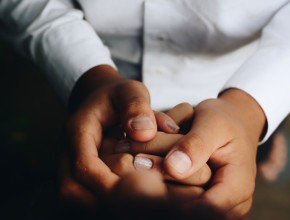In this section we usually summarize 3 articles that we consider worth knowing. Today, in a special edition of Publications of the Week, we reprint a full article which in our opinion should be read in its entirety. It is written by a McMaster University resident, Dr Joshua A. Piticaru, and we are proud to present it as part of McMaster Textbook of Internal Medicine.
This article was first published in Polish Archives of Internal Medicine: www.pamw.pl. A PDF of the article can be accessed free of charge here.
Critical caring: rediscovering humanity in the intensive care unit
The life of an internal medicine resident is one well accustomed to illness, tragedy, and death. We all start our journey in medicine eager to care for patients and make a difference, but soon enough we succumb to the pressures of information mastery, technical prowess, and increasing managerial responsibilities. Genuine interest in our patients as people is often the first casualty. In the intensive care unit (ICU), this is especially true. There is an inherent detachment that takes place when caring for a critically ill, often nonresponsive patient sustained by life support devices. And yet, each patient has a unique and complex life story. Each patient deserves our respect and compassion in their moments of unimaginable vulnerability.
It only took 1 week on service at the St. Joseph’s Healthcare ICU in Hamilton to demonstrate to me how a clear focus on patients as people can be realized. There, 2 unique programs attempt to bridge the gap between caregivers and patients. First, there is the Footprints Project,1 whereby a simple-structured paper form is given to patients’ families to request a brief outline of who the patient really is as a person. What preferred name do they go by? How would they describe themselves? What matters most to them in life? Information is abstracted and written on the Footprints Whiteboard in the patient’s room, along with a photo brought by the family. This simple solicitation and sharing of information about personhood requires minimum additional work by the health care team, and conveys so much about each patient’s footprint as an individual.
Second, for dying patients, the 3 Wishes Project2 involves soliciting ways to honor patients’ aspirations and preferences at the end of life and implement these wishes. The wishes can be those of the patient, family, or clinicians and are meant to honor the dying patient and support the family members in grief. Surprisingly, the wishes are usually simple and inexpensive, especially compared to the exorbitant daily health care resources consumed in the ICU.
I first saw these initiatives implemented in a man with community-acquired pneumonia and severe chronic obstructive lung disease who failed extubation. In conversing with us, he was clear that ongoing invasive mechanical ventilation was not consistent with his values. His last hours were spent with his dog on his lap, ice cream on his tongue, and a sip of cold beer as a final pleasure. Everyone—his family, the ICU team, and most importantly, the patient—was satisfied that he would die on his own terms. Later, a woman with end-stage interstitial lung disease experienced her last moments surrounded by her loving family drinking tea, telling stories, and listening to spiritual music, after a personalized prayer from her community pastor—free of suffering just as she had wanted. An immigrant family of Buddhist faith requested that after their mother’s death, she be washed and dressed in a traditional elegant robe. They wanted to pray, united and uninterrupted, for 8 hours following her passing. For this woman, whose son had endured such hardship as a refugee before bringing his entire family together, we were able to arrange a separate spiritual room in the hospital where her family could carry out these final faith-based wishes. Finally, an elderly gentleman with multiorgan failure was discovered to have irreversible brain injury, and life-sustaining measures were withdrawn as per his directives. We had developed a strong bond with this family, and through the Footprints Project had come to know of his active life as a father, husband, grandfather, and volunteer. We learned of his independence, attention to detail, and commitment to community. His family brought in some of his signature personal items—his little black book, miniature radio, favorite sweater, and photographs—creating a personal shrine on his bedside table. We placed a handmade quilt over him, and there was a deeply solemn moment as we extubated him with his favorite classical refrain playing softly in the background. His family held his hand as he slowly drifted off.
For these patients, none of the wishes required any extraordinary effort on behalf of the interprofessional team. What they did require was a culture of caring that illustrates to patients and their families that we are here for them, and with them, on the path right to the end of the life’s road. I only hope that this experience will stay with me as I continue not just my journey in residency, but over my career. Most of us entered this profession anticipating moments like these, to recognize and respect patients as individuals. We hope to develop meaningful relationships in times of illness and tragedy. Before many physicians complete training, these idealistic intentions are far behind us. These families showed immense gratitude for what we did to honor their loved ones despite a poor clinical outcome. Experiences like these made me realize that the way we approach patients and their families is influenced by institutional social norms, but also that the status quo can be changed for the better with inspiring grassroots, humanizing initiatives.1,2 Small, tangible acts of compassion can mean so much both to those who give and to those who receive.
I know that years later, no one—neither family members nor health care providers—will remember how well we managed the blood glucose or ventilator settings. They will remember that we knew their loved one by name and sought to see them as fellow human beings. They will recall that we helped them to experience the final hours on their own terms, and that above all, we truly cared.
References
1 Hoad N, French T, Shears M, et al. Footprints: sharing the footprints of life in the ICU. Crit Care Med. 2015; 43(12 Suppl 1):140.2 Cook D, Swinton M, Toledo F, et al. Personalizing death in the intensive care unit: the 3 Wishes Project: a mixed-methods study. Ann Intern Med. 2015 Aug 18;163(4):271-9. doi: 10.7326/M15-0502. PubMed PMID: 26167721.
3 Wishes Project. http://www.3wishesproject.com/. Accessed October 9, 2017.
 English
English
 Español
Español
 українська
українська









